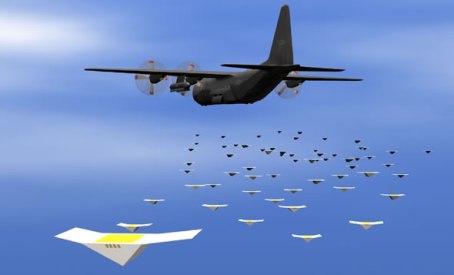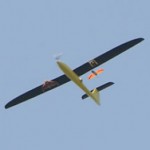Introduction
Nope, this Tech. Brief is not about the insect (Tibicen plebia) and its use as a trained information-gatherer by homeland security agencies. Rather, this brief is a continuation to the January 2012 Tech. Brief – Drones: Potential Uses and Abuses in Homeland Security – which talked about the increasing use of drones for homeland security duties.
In the January 2012 brief, the concept of Micro Air-Vehicles (MAVs) was introduced. This brief will discuss a specific MAV design, which is low-cost and disposable.
Close-In Covert Autonomous Disposable Aircraft
The Close-In Covert Autonomous Disposable Aircraft (CICADA) concept has come out of research, carried out by the United States Naval Research Laboratory (NRL), to create a system for “the low-cost delivery of multiple precision-located sensors, without placing the warfighter in harm’s way.” This has been achieved by the following design choices:
Low-cost MAV
Given the objective of having multiple sensors embedded in an area of interest, without placing a warfighter in harm’s way, the best option was to go in for a low-cost disposable platform. The CICADA is a glider: it has no on-board propulsion.
The airframe is simply a printed circuit board also serving as the autopilot, the first known multi-purpose airframe/avionics implementation of its kind. The only flight sensors are a 5Hz GPS receiver and a two-axis gyroscope. The novel construction method significantly reduces assembly time, minimizes wiring requirements. The system is powered by lithium polymer batteries, which can be plugged into a computer’s USB port and recharged using a cell phone charger.
A prototype CICADA can be seen in the figure below.
 |
| Figure 1: CICADA concept Credit: NRL (United States Naval Research Laboratory) www.nrl.navy.mil |
Low-risk delivery
The CICADA is designed to be launched from aircraft (manned or unmanned), balloons, or precision guided munitions, and dispersed in selectable patterns around designated areas. Given its lack of on-board propulsion, it requires another airborne platform to get it to an altitude such that it can glide to its destination: the device has a 3.5-to-1 glide ratio.
In the NRL demonstration (Autonomous Deployment Demonstration – ADD), stand-off distances of thirty nautical miles and altitudes of up to 57,000 feet were demonstrated.
 |
| Figure 2: CICADA delivery Credit: NRL (United States Naval Research Laboratory) www.nrl.navy.mil |
Precision-located
The CICADA is dropped from an airborne platform, glides to a single waypoint, and then enters an orbit. It descends in that orbit until it reaches the ground; with an average landing error of fifteen feet from the commanded location. Because CICADA has no propulsion system, the range and flight time vary depending on the wind speed and direction, as well as the altitude from which the system is dropped.
One of the demonstration system designs could withstand winds of up to 40 knots, while another had its avionics hardened to survive 10,000 gravitational force units for a gun-launch application.
 |
| Figure 3: Tempest mothership carries two CICADA Mk3 micro drones. Credit: NRL (United States Naval Research Laboratory) www.nrl.navy.mil |
Transmission of data
The payloads across several CICADAs can be interconnected to form an ad-hoc, self-configuring network – a Wireless Sensor Network (WSN).
 |
| Figure 4: Sensors in an ad-hoc self-configuring network, communicating with base-stations Credit: Bradley Department of Electrical and Computer Engineering, VirginiaTech http://www.ece.vt.edu/news/fall05/sensornetwork.html |
Benefits and Application Areas
The functionality of the CICADA has not been significantly affected by the design objectives. The one major limitation is the reduction in the size of the sensor payload. However, the benefits of the concept are significant and unique:
- Sensor payloads
The CICADA airframe shape can be easily scaled to accommodate various payload sizes and potential acoustic, magnetic, chemical/biological and SIGINT sensors.
Now, with the imminent availability of wireless trace-sensors, printed on paper or paper-like material using standard inkjet technology, incorporating such sensors in the airframe can be made a trivial task. - Autonomous range
The concept allows sensors to be deployed at very comfortable stand-off distances. Communication nodes, sensors, or effectors can then be placed in a programmable geometric pattern in hostile territory without directly over-flying those regions or exposing human agents on the ground. One demonstration aircraft traveled 11 miles to the target from a downwind release and still arrived at the target at an 18,000-foot altitude: then it orbited overhead and descended. - Functional Malleability
The design enables additional electronic payloads to be inserted into the system by updating the printed circuit board artwork and “re-winging” the aircraft. - Stealth profile
The absence of on-board propulsion allows the aircraft to be designed in a much smaller form-factor, and makes it virtually undetectable in flight. - Mass deployment of a network of sensors
The CICADA is designed for mass deployment. The original version featured wings that could fold down and could be deployed by the thousands from an aircraft pod. Having the ability to deploy a swarm of networkable CICADAs offers a user significant tactical advantages: using the sensors to create a user-sentient area-of-operation; and reducing sensor power and size while retaining the coverage resolution, just by having more sensors.
The use-cases for the CICADA, outside war zones, apply mainly to insurgency-affected, remote areas, where HUMINT is scarce or at grave operational risk. The sensor payloads can be tailored to specific requirements of homeland security agencies operating in an insurgency-affected area.
Conclusion
The concept of CICADA has just been proven by the United States Naval Research Laboratory. Homeland security planners in India can look at developing Indian needs-specific variants, leveraging the DRDO’s proven expertise in UAVs.



